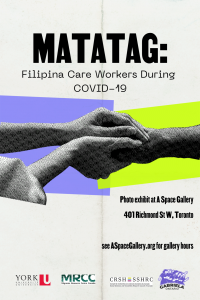Photo exhibit calls attention to plight of Pinay care workers during COVID-19
Photo exhibit calls attention to plight of Pinay care workers during COVID-19
 Policy implications on labour, immigration, and women recommended
Policy implications on labour, immigration, and women recommended
October 21, 2021
By Veronica Silva Cusi
The Philippine Reporter
A photo exhibit that launched this week brings to light some policy implications on the plight of Filipina care workers in the ongoing pandemic.
Almost 200 photos are on display at the A Space Gallery in Richmond Hill, Ont., original photos taken by care workers who participated in the study conducted last year.
Using photo voices and participatory research, the project documents the lived experiences of 78 Filipina caregivers and personal support workers from across Canada. The photos were results of a kuwentuhan (talk-story) series of webinars where care workers were given the free hand to cover topics that concern them.
Ethel Tungohan, PhD, York University Associate Professor and project collaborator, told The Philippine Reporter that photo exhibit is one way to disseminate the findings and policy recommendations drawn from the study.

Almost 200 photos representing lived experiences of Filipina care workers are on display at the A Space Gallery in Richmond Hill, Ont. The photos were taken by the care workers themselves and shared in a series of webinar-kuwentuhan (storytelling) where they presented their stories about their work during the pandemic. The exhibit runs up to January 2022.
Photo supplied
Through a series of webinars and photos taken by the care workers themselves, the study brings to light the vulnerabilities of care workers who have not been as widely talked about in the pandemic, said Tungohan.
She said that in discussions with collaborators in the project, including the Gabriela Ontario women’s group and Migrants Resource Centre Canada (MRCC), a non-profit services institution, they noted that caregivers, personal support workers, licensed practical nurses are not as widely talked about compared to other members in the community affected by COVID-19, such as the medical doctors and the patients.
“We needed to show … that care workers are affected [by the pandemic],” said Tungohan, who is York University’s Canada Research Chair in Canadian Migration Policy, Impacts and Activism (Tier 2), in a phone interview with The Philippine Reporter.
“[One] main finding [of the study] is that Filipina care workers have become more vulnerable during COVID-19. The type of care work that they do exposes the women to more experiences of vulnerability,” she said, adding that this is true especially for care workers who are live-in caregivers and those without citizenship status.
“We can see the intersection between immigration, labour, and health — all of which create more vulnerabilities for all the women involved,” she added.
The project documents the problems faced by care worker “tita’s” and “ate’s” – endearing and respectful terms Filipinos call Pinays – in the workplace using photography via smartphones.
Not only do the photos document the challenges they face during the pandemic, but they also show the resilience of Filipina care workers in finding ways to support themselves and their communities, and to fight back to attain a semblance of peace, explained Tungohan.
The online meetings also provided a sense of community gathering for the care workers, some of whom felt isolated.
Among the biggest challenges shared through the photos, which were discussed in the online meetings, were:
• The struggles of getting permanent residency status during COVID-19 when some services either slowed down or came to a halt to avoid the spread of the virus,
• No sufficient personal protective equipment,
• Having to drive from household to household but prevented from using the bathrooms in their workplaces, yet with most public spaces closed, and
• The risk of exposing their families to the virus after their work shifts.
“Every day, we stake our lives to work,” was a common comment by tita’s and ate’s shared, said Tungohan.
Other findings of the study include:
• Burnout among care workers,
• The feeling of lack of mental health support, and
• The feeling that many of their experiences were from long-held issues not resolved, such as precariousness of work that’s prone to abuse,
The project includes policy recommendations for action. Among these are:
• Equitable immigration policy changes,
• Protection for migrant workers in their workplaces,
• Funding supports to bodies that are looking after the migrant workers,
• Mental health supports,
• Systemic reforms in long-term care facilities to ensure fair compensation and a focus on public funding, and
• Continuous research on assessing working conditions to help in policy making.
“By visualizing the lived realities of Filipina care workers, we aim to make a meaningful impact on Canadian labour and immigration policies that affect them the most. As part of this project, we invite you to review, sign, and share our petition to call for rights and protection for Filipina care workers in Canada,” the exhibit invite reads.
The care workers themselves had a hand in deciding which photos are included in the exhibit, said Tungohan.
The exhibit is titled “Matatag: Filipina Care workers During COVID-19” and runs up to January 2022.
The study was funded by Social Sciences and Humanities Research Council.
Comments (0)